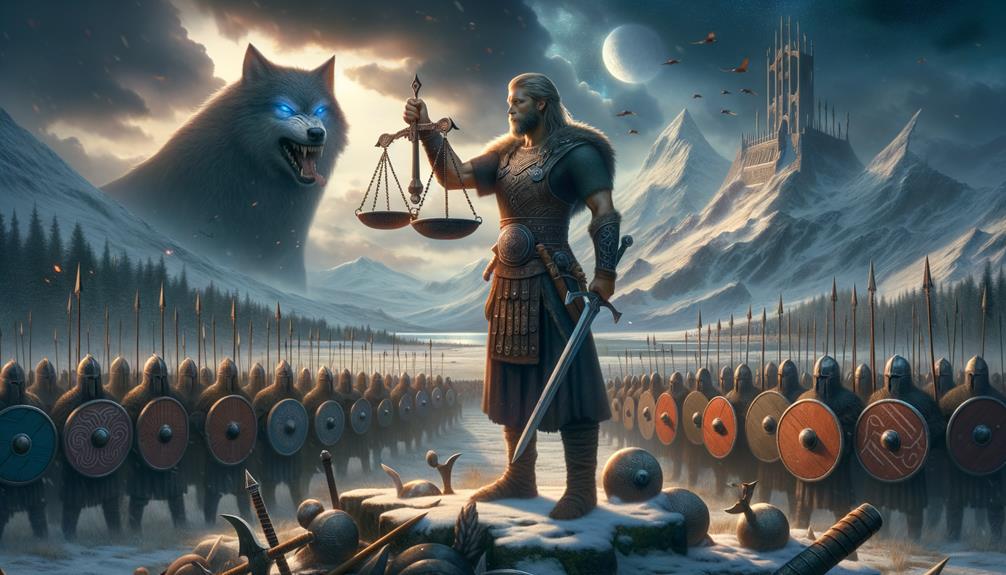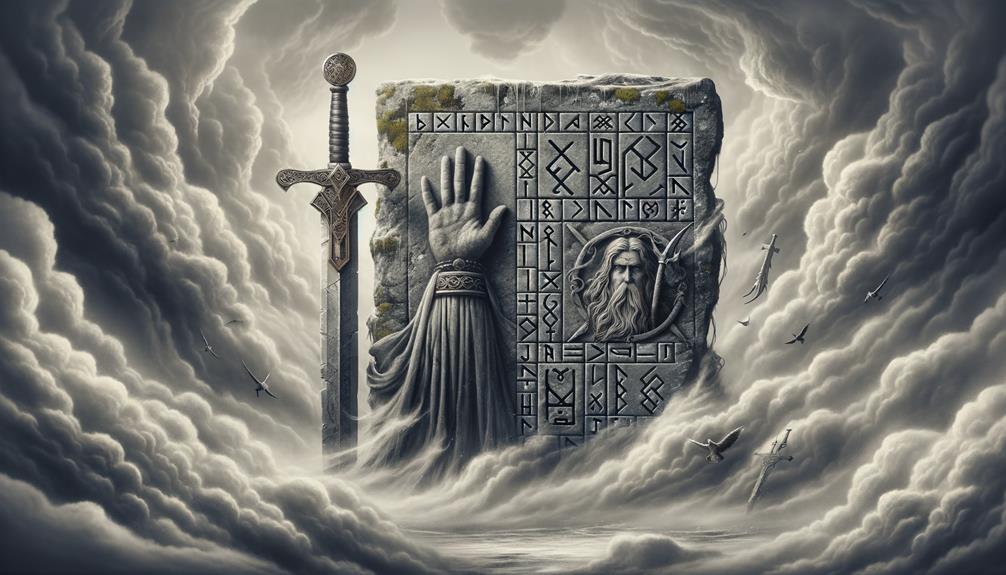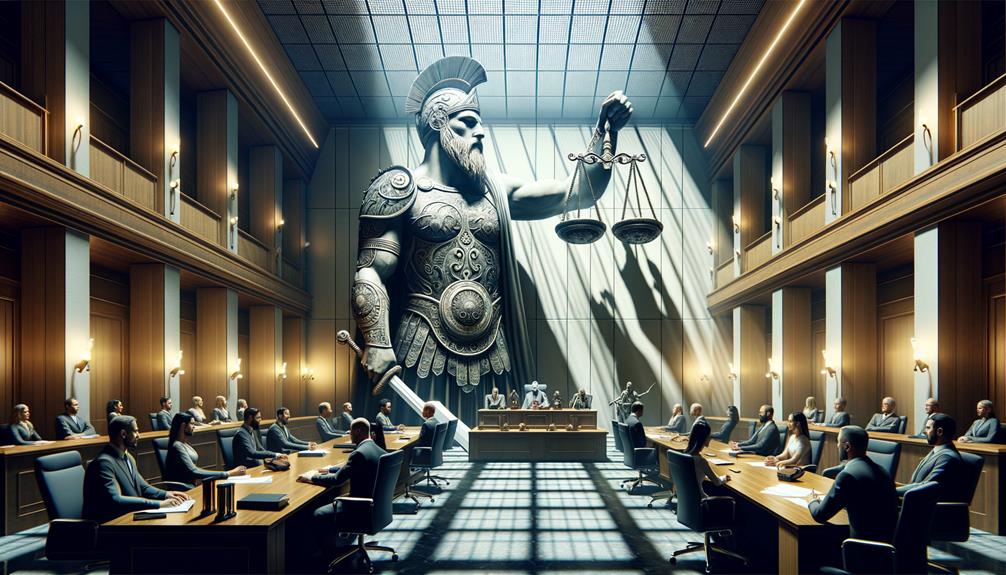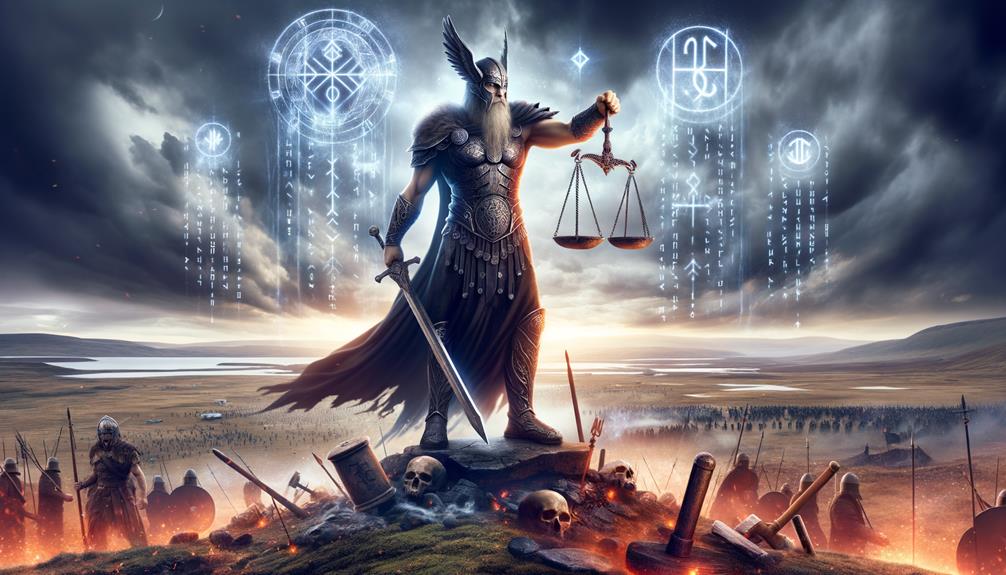Týr, the Norse god of war and justice, is a fascinating character. Some people think he's related to Odin, others say he's the son of the giant Hymir. Either way, it's clear that the Norse had a knack for blending the heavenly and the horrific.
Now, Týr is often shown as a bold fighter, brandishing a sword or spear. But it's his lost hand that really grabs your attention. This missing hand is a powerful reminder of his dedication to justice and the rules.
There's a story where Týr sacrifices his hand to keep a promise. This is part of the tale of Fenrir's binding, and it really shows how brave he was. It also makes it clear that he was seen as a sort of divine judge.
His tales, found in works like the Poetic Edda and the Prose Edda, are filled with examples of his bravery, selflessness, and fairness. But there's always more to learn about Týr. His cultural impact and modern relevance are still being explored, and his stories continue to inspire and influence us today.
Origins and Parentage of Týr
Looking at Týr's family tree, it's fascinating to see the confusion surrounding who his parents really are. Some stories claim he is the son of Odin, the king of the gods, while others, like the Hymiskviða, maintain he belongs to the Jotunn because of his father, the giant Hymir. The fact that Týr, a Norse god, could be linked to both the Aesir and the Jotunn, showcases how flexible the lines between these two groups were in Norse mythology. This might represent the delicate equilibrium between order and chaos in the Norse world. As a result, the unclear details of Týr's family background make his character richer and more intricate. He's more than just a god; he embodies the fascinating balance of divine and monstrous, order and chaos, that makes Norse mythology so engaging.
Depictions and Symbols of Týr

Let's dive into the symbols and depictions associated with Týr, the Norse god of law and war. When you think of Týr, one of the first images that might come to mind is a mighty warrior armed with a sword or spear. This is a testament to his strength and skill in battle. But there's also a more profound aspect to his character: his commitment to justice.
Týr's missing hand, a result of his sacrifice to bind the fearsome Fenrir, is a powerful symbol of his bravery and dedication to uphold the law. He's not just a fighter; he's a hero who's willing to make personal sacrifices for the greater good. Týr's calm and composed manner is another distinguishing feature, portraying him as a figure of justice and fairness in a harsh and violent world.
Týr is closely associated with the T-rune, which underscores his dual nature as a god of war and law. Even his act of self-sacrifice is seen as evidence of his nobility and honourable character.
| Depiction/Symbol | Interpretation |
|---|---|
| Sword/Spear | Emblem of his Warrior Side |
| Missing Hand | Testament to his Sacrifice in the Pursuit of Justice |
| Calm Demeanor | Symbol of Fairness and Justice |
| T-rune | Represents his Dual Role as God of War and Law |
| Sacrificial Act | Evidence of his Noble and Honourable Nature |
Týr's imagery paints the picture of a heroic warrior who stands for justice, embodying these ideals in Norse mythology.
Significant Myths Involving Týr

If you're fascinated by the richness of Norse mythology, you're likely familiar with Týr's most famous tale, the Binding of Fenrir. In this story, Týr shows his dedication to justice and law by willingly giving up his hand to keep a promise.
Here's what makes this myth so compelling:
- Týr acts as a hero, demonstrating his willingness to sacrifice for the greater good.
- The Binding of Fenrir underscores Týr's role as a divine judge, upholding the gods' laws.
- Týr's hand loss to Fenrir is a stark reminder of the seriousness of his commitment to justice.
- The story reflects the harsh realities of war, where sacrifice is often unavoidable.
- The sacrifice made by Týr is similar to Odin's, reminding us of their crucial roles in Norse mythology.
Týrs References in Ancient Texts

If we delve into ancient writings, we'll stumble upon Týr, a character from Norse mythology, whose actions and values are vibrantly portrayed in works like the Poetic Edda and the Prose Edda. The Hymiskviða is an interesting tale that showcases Týr's cleverness and team spirit. He teams up with Thor to get a cauldron from his dad, Hymir. Sigrdrífumál, on the other hand, presents a valkyrie invoking Týr through runic charms, which points to his significant role in Norse rituals.
In another text, Lokasenna, Týr's courage shines through as he stands up for Freyr against Loki's jibes. There's even a mention of him giving up his hand, a sacrifice that is further explained in the Prose Edda. It turns out, Týr willingly sacrificed his hand to restrain the fearsome wolf, Fenrir.
When you put all these texts together, Týr emerges as a symbol of courage, selflessness, and justice, which explain why he is so respected in Norse mythology.
Týrs Influence in Modern Culture

Tyr's effect on our modern world is far-reaching, spanning across different aspects of contemporary culture from language and music to literature and video games.
- Tuesday got its name after Tyr in Old English, a testament to his ongoing cultural significance.
- The Romans linked Tyr with Mars, revealing the intricate symbolism in Tyr's myth.
- Tyr's timeless narratives find fresh interpretations in modern art and literature, showcasing his continued relevance.
- The 'Tyr' album by Black Sabbath points to Tyr's influence in the music industry.
- Tyr's role in the video game Age of Mythology shows his appeal to today's audiences.
These examples illustrate that Tyr's influence isn't confined to the past. Instead, it creatively connects ancient traditions with today's culture.
Frequently Asked Questions
Who Is the Norse God of Justice?
You know what's really cool about Norse mythology? There's this one god who's all about justice. I mean, this deity is the real deal when it comes to keeping things fair and square. No matter what, they stick to their principles, even if it means giving up something of their own. They're the ones in charge of keeping oaths and contracts intact. Pretty awesome, right?
What Is Tyr the God Of?
Let me tell you about Tyr, a real powerhouse in mythology. You see, he's not just any old god, he's the god of courage, honor, and justice. People look up to him, admire him really, for his unmatched skills when it comes to strategy in war.
Who Is the God of War and Justice?
You're talking to the right entity. I am responsible for both war and justice, maintaining harmony between the chaotic and orderly aspects of these realms. I ensure that contracts are upheld, oaths are guarded, and treaties are honored.
Who Is the Norse God of Law and Justice?
You know, it's interesting, there isn't a Norse god who's specifically named as the one in charge of law and justice. However, you could make a good case for it being a figure who's all about fairness and holds people to their promises – sort of a divine judge, if you will.


